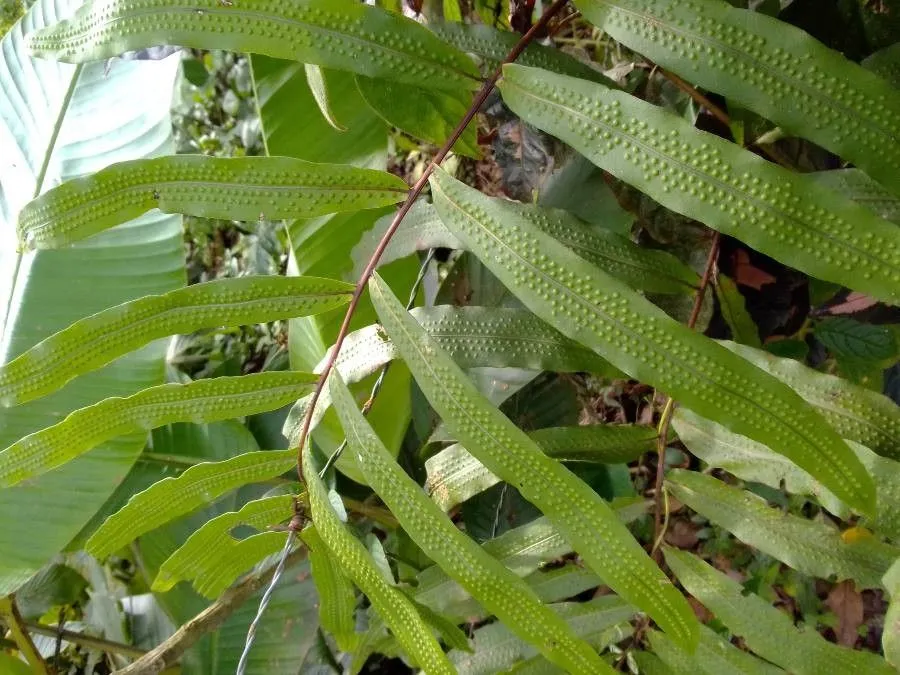
Author: A.R.Sm. (Sw.)
Bibliography: Smith AR, Kreier H-P, Haufler CH, Ranker TA, Schneider H (2006) Serpocaulon (Polypodiaceae), a New Genus Segregated from Polypodium. Taxon 55(4): 919-930. doi: 10.2307/25065686.
Year: 2006
Status: accepted
Rank: species
Genus: Serpocaulon
Vegetable: False
Observations: Trop. & Subtrop. America
Angle-vein Fern (Serpocaulon triseriale)
The Angle-vein fern, scientifically known as Serpocaulon triseriale, is a fascinating species native to tropical and subtropical regions of the Americas. This delicate fern belongs to the large and diverse Polypodiaceae family.
Serpocaulon triseriale was reclassified into its current genus based on a comprehensive study by Smith et al. (2006), who recognized significant morphological and genetic distinctions from the previously broader Polypodium genus. This reclassification reflects ongoing efforts to refine botanical nomenclature and better understand evolutionary relationships within fern species.
The Angle-vein fern is characterized by its intricate, veiny fronds, which contribute not only to its common name but also to its aesthetic appeal. These fronds exhibit a unique angular pattern, in contrast to the more rounded or elongated forms seen in other ferns, making it a distinctive member of the Polypodiaceae family. Its delicate structure and visually striking veins attract not only botanists and horticulturists but also fern enthusiasts who seek to cultivate it in suitable environments that mimic its natural habitat.
In the wild, Serpocaulon triseriale thrives across a range of altitudes in tropical and subtropical regions, from lowland forests to mountainous areas. These ferns are resilient, flourishing in humid conditions with ample shade and moderate sunlight.
A thorough understanding of the Angle-vein fern enhances our appreciation for the biodiversity found in tropical and subtropical climates. It also underscores the importance of continued botanical research, as exemplified by the meticulous work of Smith and his colleagues, who significantly contributed to our current knowledge by distinguishing Serpocaulon as a new genus.
Eng: angle-vein fern
En: Angle-vein Fern
: Anglevein fern
Taken Apr 17, 2019 by OTS – N. Zamora (cc-by-nc-sa)
Taken Apr 17, 2019 by OTS – N. Zamora (cc-by-nc-sa)
Taken May 3, 2021 by Santos Marco (cc-by-sa)
Taken Sep 19, 2020 by Oses Andrei (cc-by-sa)
Taken Sep 19, 2020 by Oses Andrei (cc-by-sa)
© copyright of the Board of Trustees of the Royal Botanic Gardens, Kew.
© copyright of the Board of Trustees of the Royal Botanic Gardens, Kew.
© copyright of the Board of Trustees of the Royal Botanic Gardens, Kew.
Taken Oct 30, 2015 by OTS – Chaves-Fallas, José Miguel (cc-by-nc-sa)
Taken Apr 17, 2019 by OTS – N. Zamora (cc-by-nc-sa)
Taken Apr 17, 2019 by OTS – N. Zamora (cc-by-nc-sa)
Taken Oct 30, 2015 by OTS – Chaves-Fallas, José Miguel (cc-by-nc-sa)
Taken Oct 30, 2015 by OTS – Chaves-Fallas, José Miguel (cc-by-nc-sa)
Taken Oct 30, 2015 by OTS – Chaves-Fallas, José Miguel (cc-by-nc-sa)
Family: Myrtaceae Author: (F.Muell.) K.D.Hill & L.A.S.Johnson Bibliography: Telopea 6: 402 (1995) Year: 1995 Status:…
Family: Rubiaceae Author: Pierre ex A.Froehner Bibliography: Notizbl. Bot. Gart. Berlin-Dahlem 1: 237 (1897) Year:…
Family: Sapindaceae Author: Koidz. Bibliography: J. Coll. Sci. Imp. Univ. Tokyo 32(1): 38 (1911) Year:…
Family: Asteraceae Author: A.Gray Bibliography: Pacif. Railr. Rep.: 107 (1857) Year: 1857 Status: accepted Rank:…
Family: Fabaceae Author: Medik. Bibliography: Vorles. Churpfälz. Phys.-Ökon. Ges. 2: 398 (1787) Year: 1787 Status:…
Family: Aspleniaceae Author: (Cav.) Alston Bibliography: Bull. Misc. Inform. Kew 1932: 309 (1932) Year: 1932…